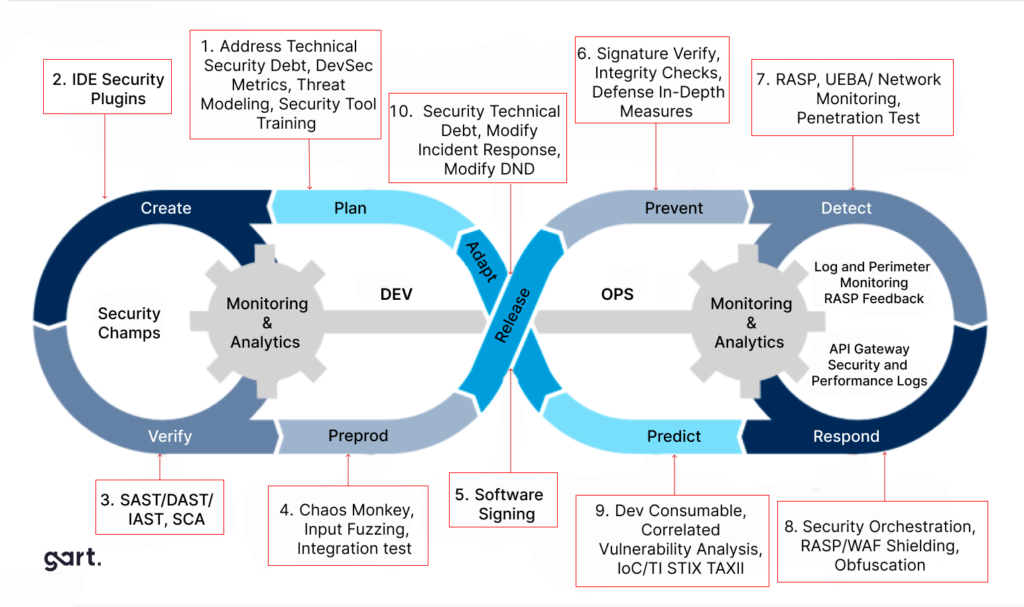In recent times, there has been a growing urgency regarding the security concerns of the developed software. Integrating secure development practices into the current processes has become imperative.
This is where DevSecOps comes into play—a powerful methodology that seamlessly integrates security practices into the software development process. In this article, we will explore the world of DevSecOps tools and how they play a pivotal role in enhancing software security, enabling organizations to stay one step ahead of potential threats.

Understanding DevSecOps Tools
DevSecOps tools are software applications and utilities designed to integrate security practices into the DevOps (Development and Operations) workflow. These tools aim to automate security checks, improve code quality, and ensure that security measures are an integral part of the software development process.
Some popular DevSecOps tools include:
Continuous Integration (CI) tools for security testing
Continuous Integration (CI) tools play a vital role in automating security testing throughout the development pipeline. They enable developers to regularly test code changes for vulnerabilities and weaknesses, ensuring that security is integrated into every stage of development.
Continuous Deployment (CD) tools for secure deployment
Continuous Deployment (CD) tools facilitate the secure and automated release of software into production environments. By leveraging CD tools, organizations can ensure that security measures are applied consistently during the deployment process.
? Read more: Exploring the Best CI/CD Tools for Streamlined Software Delivery
Security Information and Event Management (SIEM) tools for monitoring and incident response
SIEM tools help organizations monitor and analyze security events across their infrastructure. By providing real-time insights and automated incident response capabilities, SIEM tools empower teams to swiftly detect and respond to potential security breaches.
Here is a list of SIEM (Security Information and Event Management) tools: Splunk, IBM QRadar, ArcSight (now part of Micro Focus), LogRhythm, Sumo Logic, AlienVault (now part of AT&T Cybersecurity), SolarWinds Security Event Manager, Graylog, McAfee Enterprise Security Manager (ESM), Rapid7 InsightIDR.
Static Application Security Testing (SAST) tools for code analysis
SAST tools analyze the source code of applications to identify security flaws, vulnerabilities, and compliance issues. Integrating SAST into the development workflow allows developers to proactively address security concerns during the coding phase.
Some examples of Static Application Security Testing (SAST) tools: Fortify Static Code Analyzer, Checkmarx, Veracode Static Analysis, SonarQube, WhiteSource Bolt, Synopsys Coverity, Kiuwan, WebInspect, AppScan Source, Codacy
Key Features of SAST Solutions:
- Code Analysis: SAST solutions perform in-depth code analysis to identify security issues, such as SQL injection, cross-site scripting (XSS), and buffer overflows.
- Early Detection: By integrating SAST into the development workflow, security issues can be identified and addressed during the coding phase, reducing the cost and effort required to fix vulnerabilities later in the development cycle.
- Continuous Scanning: SAST solutions can be configured for continuous scanning, allowing developers to receive real-time feedback on security issues as code changes are made.
- Integration with CI/CD Pipelines: SAST tools seamlessly integrate with Continuous Integration/Continuous Deployment (CI/CD) pipelines, ensuring security testing is an integral part of the software development process.
- Compliance Checks: SAST solutions can help organizations adhere to industry-specific and regulatory security standards by identifying code that may violate compliance requirements.
- False Positive Reduction: Modern SAST solutions employ advanced algorithms and heuristics to reduce false positives, providing developers with more accurate and actionable results.
- Language Support: SAST solutions support a wide range of programming languages, enabling organizations to secure diverse application portfolios.
- Remediation Guidance: SAST tools often provide guidance on how to remediate identified vulnerabilities, helping developers address security issues effectively.
Dynamic Application Security Testing (DAST) tools for web application scanning
DAST tools perform dynamic scans of web applications in real-time, simulating attacks to identify potential vulnerabilities. By testing applications from the outside, DAST tools offer a comprehensive view of security risks.
Here is a list of Dynamic Application Security Testing (DAST) tools: OWASP ZAP (Zed Attack Proxy), Burp Suite, Acunetix, Netsparker, WebInspect, Qualys Web Application Scanning (WAS), AppScan Standard, Trustwave App Scanner (formerly Cenzic Hailstorm), Rapid7 AppSpider, Tenable.io Web Application Scanning.
Key Features of DAST Solutions:
- Web Application Scanning: DAST tools focus on web applications and assess their security from an external perspective by sending crafted requests and analyzing responses.
- Real-World Simulation: DAST solutions mimic actual attack scenarios, including SQL injection, cross-site scripting (XSS), and other common security threats, to identify vulnerabilities.
- Comprehensive Coverage: DAST solutions analyze the entire application, including dynamic content generated by the server, to detect security issues across different pages and functionalities.
- Automation and Scalability: DAST tools can be automated to perform regular and extensive scans, making them suitable for large-scale web applications and continuous testing.
- Out-of-Band Testing: DAST solutions can identify vulnerabilities not discoverable through traditional scanning, such as those found in non-standard HTTP methods or custom headers.
- Reduced False Positives: Modern DAST tools employ advanced techniques to minimize false positives, providing developers with accurate and reliable security findings.
- Integration with CI/CD Pipelines: DAST solutions can be seamlessly integrated into CI/CD pipelines, allowing security testing to be an integral part of the software development process.
- Compliance Support: DAST tools help organizations meet industry standards and regulatory requirements by detecting security weaknesses that may lead to compliance violations.
- Continuous Monitoring: Some DAST solutions offer continuous monitoring capabilities, enabling developers to receive real-time feedback on security issues as the application changes.
Interactive Application Security Testing (IAST) tools for real-time code analysis
IAST tools provide real-time security analysis by observing application execution. By combining dynamic and static analysis, IAST tools offer deeper insights into application security while minimizing false positives.
Here is a list of IAST (Interactive Application Security Testing) tools: Contrast Security, Hdiv Security, RIPS Technologies, Seeker by Synopsys, Waratek AppSecurity for Java, Quotium Seeker, ShiftLeft, WhiteHat Security Sentinel IAST, AppSecTest by Pradeo, IriusRisk IAST.
Key Features of IAST Solutions:
- Real-Time Analysis: IAST tools continuously monitor applications in real-time as they execute, capturing data on code behavior and interactions with the system to detect security flaws.
- Code-Level Visibility: IAST solutions provide detailed information about vulnerabilities, including the exact line of code responsible for the issue, helping developers pinpoint and fix problems with greater accuracy.
- Low False Positives: IAST reduces false positives by directly observing application behavior, resulting in more precise identification of true security vulnerabilities.
- Minimal Performance Impact: IAST operates with low overhead, ensuring that security testing does not significantly impact the application’s performance during runtime.
- Comprehensive Security Coverage: By analyzing code execution paths, IAST solutions identify a wide range of vulnerabilities, including those arising from data flow, configuration, and authentication.
- Seamless Integration: IAST tools easily integrate into existing development and testing environments, supporting various programming languages and frameworks.
- Continuous Security Monitoring: IAST solutions enable continuous monitoring of applications, offering ongoing security assessment throughout the development lifecycle.
- DevSecOps Collaboration: IAST fosters collaboration between development, security, and operations teams by providing real-time insights accessible to all stakeholders.
- Remediation Guidance: IAST solutions not only identify vulnerabilities but also offer actionable remediation guidance, streamlining the process of fixing security issues.
- Compliance Support: IAST assists organizations in meeting regulatory requirements by providing accurate and detailed security assessments.
Runtime Application Self-Protection (RASP) tools for runtime security
RASP tools operate within the application runtime environment, actively monitoring for malicious behavior and automatically blocking potential threats. These tools provide an additional layer of protection to complement other security measures.
Here is a list of RASP (Runtime Application Self-Protection) tools: Sqreen, Contrast Security, Waratek AppSecurity for Java, StackRox, Veeam PN (Powered Network), Guardicore, Aqua Security, Datadog Security Monitoring, Wallarm, Arxan Application Protection.
Key Features of RASP Solutions:
- Real-Time Protection: RASP tools actively monitor application behavior during runtime, detecting and blocking security threats as they occur in real-time.
- Immediate Response: By residing within the application, RASP can take immediate action against threats without relying on external systems, ensuring faster response times.
- Application-Centric Approach: RASP solutions focus on protecting the application itself, making them independent of external security configurations.
- Automatic Policy Enforcement: RASP automatically enforces security policies based on the application’s behavior, mitigating vulnerabilities and enforcing compliance.
- Precise Attack Detection: RASP can identify and differentiate between legitimate application behavior and malicious activities, reducing false positives.
- Low Performance Overhead: RASP operates with minimal impact on application performance, ensuring efficient security without compromising user experience.
- Runtime Visibility: RASP solutions provide real-time insights into application security events, helping developers and security teams understand attack patterns and trends.
- Adaptive Defense: RASP can dynamically adjust its protection strategies based on the evolving threat landscape, adapting to new attack vectors and tactics.
- Application-Aware Security: RASP understands the unique context of the application, allowing it to tailor security responses to specific application vulnerabilities.
- Continuous Protection: RASP continuously monitors the application, offering ongoing security coverage that extends throughout the application’s lifecycle.
- DevSecOps Integration: RASP seamlessly integrates into DevSecOps workflows, empowering developers with real-time security feedback and enabling collaboration between teams.
- Compliance Support: RASP helps organizations meet regulatory requirements by providing active protection against security threats and potential data breaches.
DevSecOps Tools Table
| Category | DevSecOps Tool |
| CI/CD | Jenkins, GitLab CI, Travis CI, CircleCI |
| SAST | SonarQube, Veracode, Checkmarx, Fortify |
| DAST | OWASP Zap, Burp Suite, Acunetix, Netsparker |
| IAST | Contrast Security, RASPberry |
| RASP | Sqreen, AppTrana, Guardicore |
| SIEM | Splunk, IBM QRadar, ArcSight, LogRhythm |
| Container Security | Aqua Security, Sysdig, Twistlock |
| Security Orchestration | Demisto, Phantom, Resilient |
| API Security | Postman, Swagger Inspector |
| Chaos Engineering | Gremlin, Chaos Monkey, Pumba |
| Policy-as-a-Code | Open Policy Agent (OPA), Rego, Kyverno |
Empower your team with DevOps excellence! Streamline workflows, boost productivity, and fortify security. Let’s shape the future of your software development together – inquire about our DevOps Consulting Services.









